You and your loved ones (both human and furry!) spend a lot of time living, resting, playing, and eating on your furniture. So with all that time spent, you probably want to make sure you’re buying non-toxic furniture that’s safe for your family and as healthy as possible for your home.
So in this guide, you’ll learn about what to look for in non-toxic furniture, and then we’ll give your our favorite brands to shop from that are using the safest non-toxic materials.
Click here to skip right to the brands (or keep scrolling for more info on what makes furniture non-toxic).
Table of Contents
- How Do You Know if Furniture is Non-Toxic?
- Certifications
- Low or No Formaldehyde
- Low or No VOC Finishes
- No Flame Retardants
- No PFAS
- No PVC
- Natural & Organic Materials
- The 9 Best Non-Toxic Furniture Brands
- 1. Medley
- 2. Savvy Rest
- 3. Natural Home By The Futon Shop
- 4. Ecobalanza
- 5. Avocado
- 6. Burrow
- 7. Green Cradle
- 8. Sabai
- 9. IKEA
- What About West Elm and Pottery Barn?
- What About Non-Toxic Outdoor Furniture?
- Related Guides:
- More FAQs About Non-Toxic Furniture
- Is the Smell From New Furniture Toxic?
- How Long Will Furniture Off Gas?
- How Do You Get Formaldehyde Out of Furniture?
- Where Can You Buy Non-Toxic Furniture?
- What is the Safest Furniture?
- What is Organic Furniture?
- How Do You Know If You’re Buying Solid Wood Furniture?
- Is Ashley Furniture Non-Toxic?
- Is Ethan Allen Furniture Toxic?
- Is Bamboo Furniture Toxic?
- Is Metal Furniture Toxic?
- Is Plastic Furniture Toxic?
- Is Leather Furniture Toxic?
- Do Leather Couches Have Flame Retardants?
- Is MDF Furniture Toxic?
- Is Pine Furniture Toxic?
- Is Laminate Furniture Toxic?
- Does All Furniture Have Formaldehyde?
This article contains affiliate links, which means we may earn a commission if you choose to make a purchase. As always, we only make recommendations that are genuine.
Featured Image Credit: Natural Home By The Futon Shop
How Do You Know if Furniture is Non-Toxic?
Certifications
There are several different kinds of certifications out there. You might recognize labels like OEKO-TEX, GREENGUARD, MADE SAFE, Certi-PUR, Global Organic Textile Standard (GOTS), Forest Stewardship Council (FSC), and more.
Each of these certifications comes with pros and cons. Overall, certifications do indicate a certain level of safety when it comes to the materials used. They help to provide companies with some accountability, as they have to be verified with a third party that they don’t contain certain toxic chemicals.
However, certifications don’t always mean a product is 100% non-toxic. Although they all have safety standards and restrictions in place, they’re not perfect. For example, there are currently only two certifications (to our knowledge) that completely restrict PFAS a.k.a “forever chemicals.” Those two certifications are MADE SAFE and GreenScreen. (As of right now, OEKO-TEX restricts certain types of PFAS, but not all of them. The good news is that they have recently amended their PFAS policy so that beginning in 2024, OEKO-TEX certified products will have to be free from all PFAS.)
It’s also worth noting that certifications do cost brands money to acquire and maintain. This usually won’t be a problem for larger and more established brands; however, smaller artisan companies may not be able to afford it. Just because a brand isn’t certified doesn’t automatically mean it’s toxic or less safe.
All of that being said, we definitely recommend looking for third-party certifications when possible since certified non-toxic furniture brands are generally going to be your best bet.
Low or No Formaldehyde
Now let’s talk about formaldehyde-free furniture. First, it’s worth noting that formaldehyde is a naturally-occurring substance and it exists in small amounts all over the place—even in human bodies. So completely formaldehyde-free furniture isn’t really a thing… However, this is mostly a matter of semantics because what you should really be looking for is furniture that is LOW in formaldehyde and does not have added formaldehyde from things like glues and resins.
When formaldehyde is in our environment at higher concentrations, that’s when it can start causing problems, from skin irritation to cancer.
The place where you’ll usually find the most formaldehyde in furniture is in engineered wood, which include MDF (medium-density fiberboard), plywood, or particleboard. These types of engineered wood are actually made by gluing a bunch of wood pieces (like chips or sawdust) together using a LOT of glue… And that glue almost always contains high amounts of formaldehyde and other volatile organic compounds (or VOCs).
So when buying non-toxic furniture, we recommend going for solid wood whenever possible.
That said, sometimes it can be difficult to avoid engineered wood altogether, especially if there are budget concerns. Sometimes furniture makers also use plywood in certain aspects of a piece of furniture because it won’t expand or contract, so it provides more stability for the piece. (That’s why it’s often used for things like the back/bottoms of drawers and bookshelves.)
So if you do go for a brand that uses engineereed wood, look for ones that either use no-formaldehyde glues and/or are compliant with California’s CARB II / US TSCA Title VI. These regulations ensure that formaldehyde levels are minimal.
Low or No VOC Finishes
Speaking of volatile organic compounds, you’ll also want to look for low or no-VOC lacquers and finishes on your furniture.
In short, VOCs are a family of chemicals that can vaporize at room temperature. They include harmful substances that can decrease your indoor air quality, potentially causing problems from lung irritation to cancer.
Conventional furniture is typically finished with harsh, VOC-laden lacquers, so you’ll want to look for brands that are using things like natural linseed oil or water-based finishes instead.
You can read this article to get more info about VOCs.
No Flame Retardants
When it comes to flame retardants in furniture, there is good news! These toxic chemicals (associated with everything from cancer and thyroid disease to fertility problems and decreased IQ) have actually been largely restricted and/or banned in recent years, and even conventional furniture companies like Ashley Furniture have started getting rid of them completely.
In the past, flame retardants have been added to polyurethane foam, which is a more flammable material since it’s derived from petroleum. Unfortunately, however, investigations have shown that these toxic chemicals don’t even slow down fires.
A California law that went into effect in 2020 banned fire retardants in children’s products, mattresses, and upholstered furniture. That means that any furniture brand that sells to California residents has had to say bye-bye to toxic flame retardants in recent years. Although we’re not totally in the clear since flame retardants are still used by some companies, it’s now much easier to find brands that do not use them at all.
You can dive deeper into flame retardant chemicals (including how to read couch labels to see if these substances are present) in our guide to non-toxic sofas and couches.
Home
The Best Safe Sofa & Non-Toxic Couch Brands for 2024
You likely spend a lot of time on your couch, whether you’re snuggling up for a good show or gathering together with loved ones for game night. Here’s what to look for in a non-toxic sofa and our favorite eco-friendly brands.
No PFAS
PFAS stands for per-and polyfluoroalkyl substances. This is a family of chemicals that has gained the nickname “forever chemicals” since they don’t break down. Instead, they just stick around and build up in our bodies and environments over time.
You may have heard about PFAS from the movie, Dark Waters, or the related documentary, The Devil We Know. These films share the shameful story of DuPont, the Teflon manufacturer that knowingly poisoned an entire town (multiple towns, actually) with its toxic PFAS.
In addition to making eggs slide off of a pan more easily, PFAS also supposed make fabric water- and stain-resistant, which is why they’re often added to furniture. (Even though, it appears that similarly to flame retardants, they don’t even work that well.)
There is good and bad news on the PFAS front. Although a lot of furniture companies still use PFAS on their furniture, state and federal legislators are finally starting to do something about it by implementing PFAS bans on certain products. My guess is that over the next decade, PFAS will largely be phased out of furniture altogether. You can keep track of current PFAS legislation in your state right here.
No PVC
PVC can be used to make vegan leather alternatives. However, as we’ve talked about before, PVC is one of the most toxic kinds of plastic. It contains chlorine, which creates byproducts called dioxins and furans, which are linked to cancer, reproductive and developmental problems, and more.
Not only that, but PVC almost always contains phthalates, which are known endocrine disruptors and are linked to a list of various negative health outcomes.
Natural & Organic Materials
While natural and organic fabrics are definitely always better for some things (like underwear, for example!), when it comes to furniture, it’s not always so straightforward.
First of all, some synthetic fabrics tend to be more resistant to mold growth compared to certain natural fabrics like organic cotton. For those with CIRS or sensitivity to mold, this can be a compelling reason to consider getting upholstered furniture made with something like polypropylene.
That being said, there are now brands that have managed to make highly durable fabrics out of natural and organic fabrics!
Additionally, keep in mind anything can be made from natural and/or organic materials but still have toxic additives. I would argue that it’s better to get a sofa made with a synthetic fabric but that is PFAS-free (like Burrow, for example) as opposed to a sofa that’s made from certified organic cotton fabric but then has toxic stain-resistant finishes added to it.
At the end of the day, you will have the make the best decision for you based on your own needs, budget, aesthetic preferences, etc. Many of the brands below use mostly natural/organic materials, but we’ve also included some that use synthetics that are PFAS-free.
The 9 Best Non-Toxic Furniture Brands
Whether you or your loved ones are chemically sensitive or you’re just trying to decrease the amount of toxic materials in your life as a preventative measure, buying non-toxic and eco-friendly furniture is a great way to promote and maintain human health.
Here are our favorite natural and low-tox furniture brands:
1. Medley
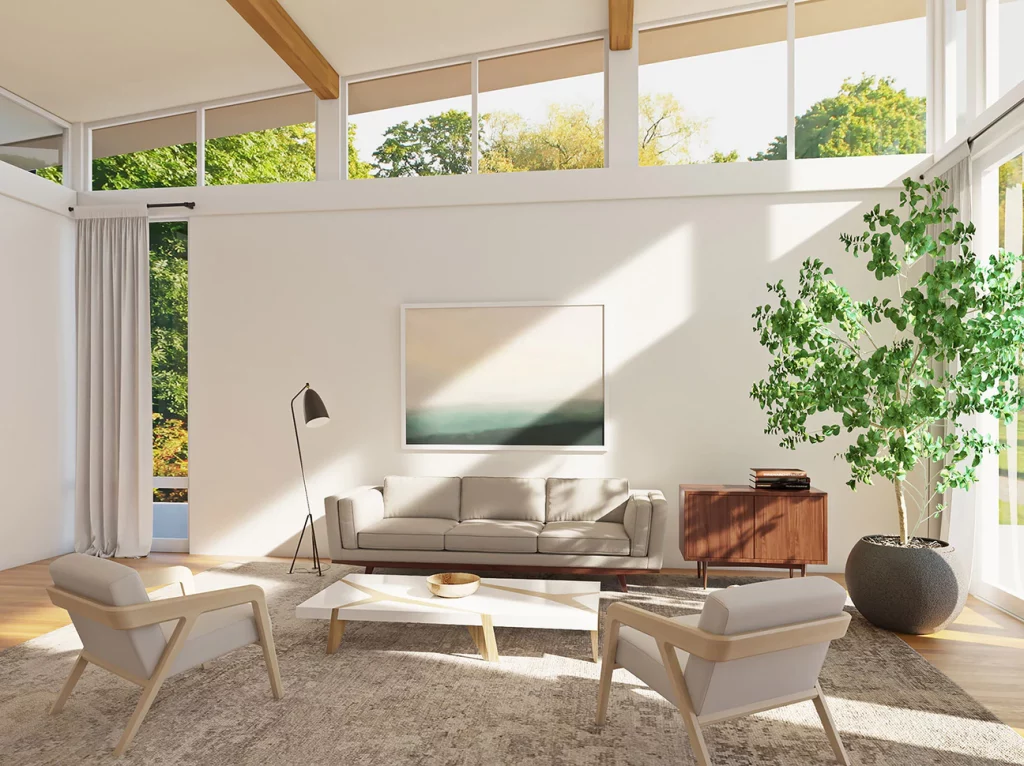
Carries: Sofas (including sectionals, sleeper sofas, and ottomans), Accent Chairs, End Tables, Coffee Tables, Dining Room Tables, Office Furniture, and More
Price Range: ~$1,095 – $6,299
Medley is a great eco-friendly furniture brand that carries beautiful modern and minimalistic designs. They use sustainable materials like FSC certified wood, zero-VOC glues, and certified organic natural Dunlop latex… all of which are free from any fire retardants or PFAS.
For their wooden furniture, they use FSC-certified kiln-dried alder hardwood, solid Walnut, and Maple. The backs and bottoms of their storage pieces use low-VOC CARB II compliant plywood. The wood is finished with a plant-based, hardwax oil wood finish that is odorless, 0% VOC, and water- and heat-resistant.
For the couch and sectional cushions, you have the option of getting Natural Dunlop Latex or CertiPUR PU foam. For fire resistance, they use OEKO-TEX certified wool.
They have a lot of fabric options, both natural and synthetic. Natural options include cotton and linen—and all of those are GREENGUARD Gold, GOTS, and/or or OEKO-TEX 100 certified. Synthetic options include polyester, polypropylene, and acrylic—those ones are OEKO-TEX certified. You can order free samples to figure out which fabric is best for you!
Everything is handcrafted in the USA, in Los Angeles, California. Additionally, Medley offers financing through Affirm, starting at 0% interest, and a 15-day trial & return policy.
Use the code THEFILTERY5 for 5% off your order.
2. Savvy Rest
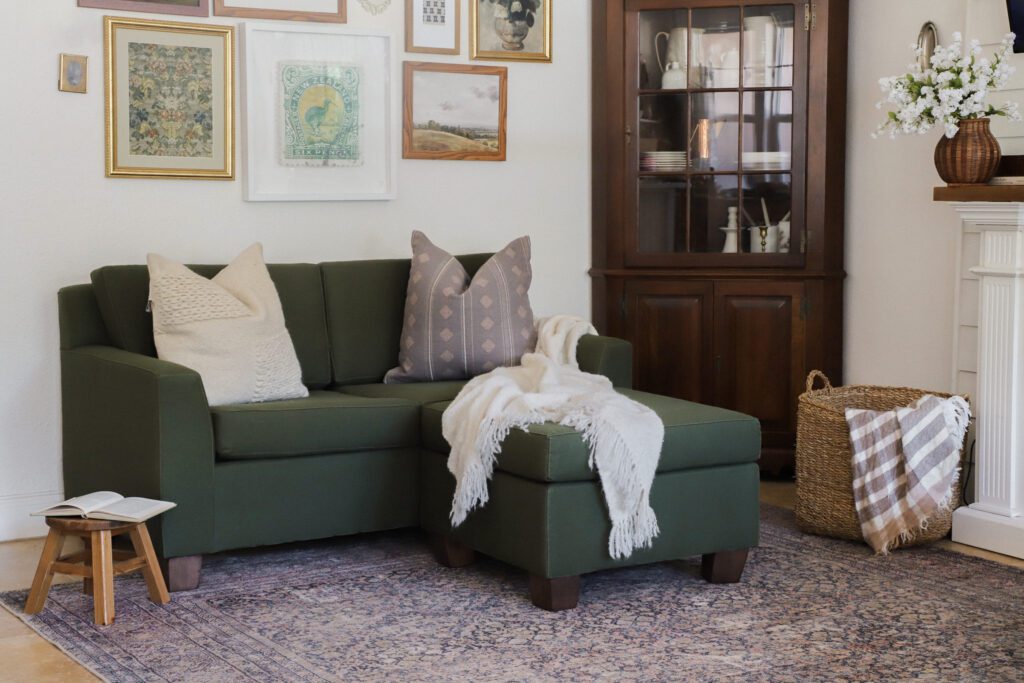
Carries: Bedroom Furniture, Sofas (including armchairs, loveseats, and ottomans), Tables, Benches, and Cribs (as well as other bedroom essentials like pillows, sheets, and more)
Price Range: ~$749 – $3,999
To make their furniture as sustainably as possible, Savvy Rest works on a made-to-order basis in order to decrease wood waste. Their customizable furniture is made using things like solid wood and zero VOC finishes like natural linseed oil (or you can also get unfinished!).
Their line of mattresses is free from toxic chemicals and is instead made from safe materials like organic natural latex, organic wool, and organic cotton.
Savvy Rest’s natural furniture is also made in the USA, is GREENGUARD certified, and is completely free from things like chemical flame retardants and PFAS.
Use code THEFILTERY20 for 20% off.
3. Natural Home By The Futon Shop
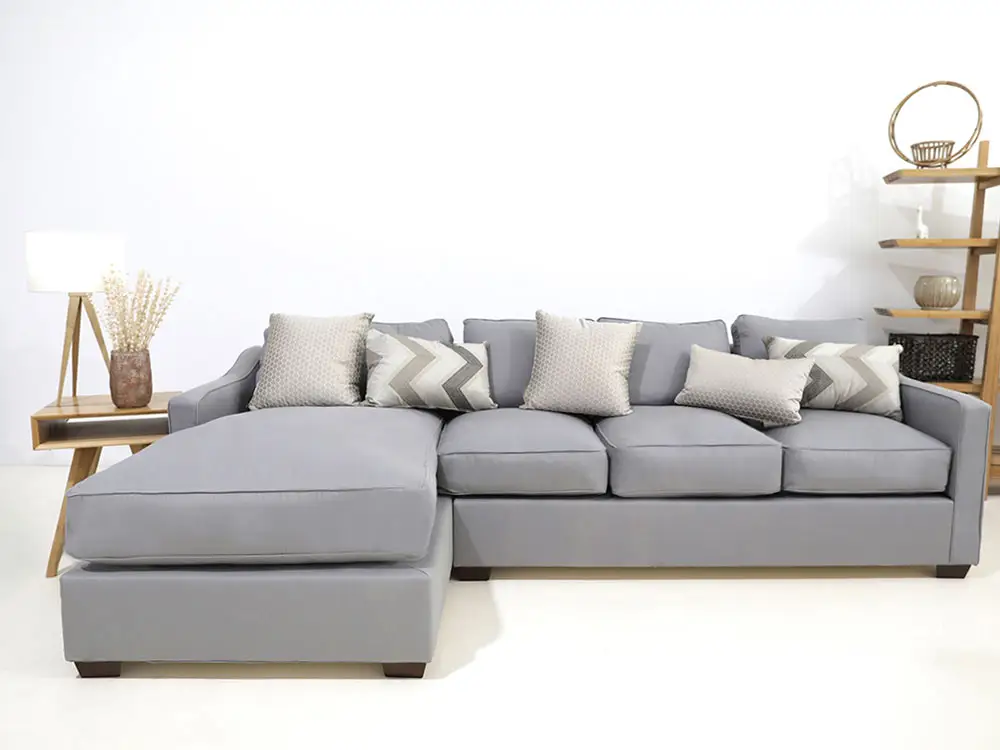
Carries: Sofas & Sectionals, Sofa Beds, Mattresses & Bed Frames, Cribs, Futons (of course!) Arm Chair + Ottoman
Price Range: ~$385 (on sale) – $4,000
For their non-toxic furniture, Natural Home by The Futon Shop does not use any petroleum-based products like PU foam, glues, or other harsh chemicals.
Instead, they use materials like solid wood, coconut coir, latex, hemp, and wool. (For a vegan option, they use PLA from potato starch instead of wool.) Their materials come with several third-party certifications, including GOTS, GOLS, and OEKO-TEX. All of their fabrics are PFAS-free as well.
For seating, they offer a variety of different designs, from mid-century modern, to fold-down sofa beds, to arm chair + ottoman combos, and more.
For beds, they have minimalistic platform beds, upholstered bed frames, and other designs. You can choose from a variety of different types of solid wood, but it’s all free from things like formaldehyde-emitting glues and other harsh VOCs.
Some of The Futon Shop’s furniture is ready to ship and other pieces are made to order, to make sure to check the estimated delivery time to make sure it works with your schedule.
4. Ecobalanza
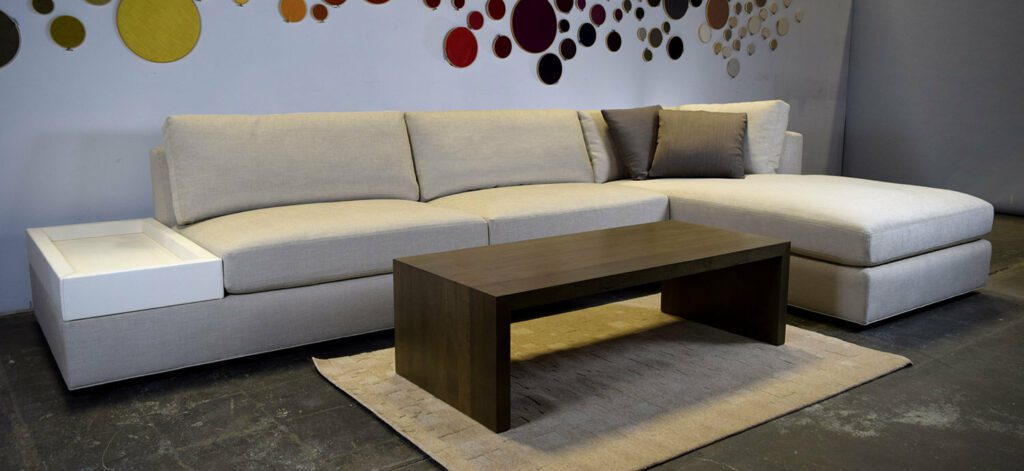
Carries: Sofas & sectionals, headboards/bed frames, arm chairs, custom furniture
Ecobalanza uses materials like GOLS certified Dunlop latex for the cushions, GOTS organic cotton and wool batting, natural kapok, FSC-certified solid Adler and Western Maple wood, and zero-VOC stains. Their furniture comes with a handful of other third-party certifications as well, including OEKO-TEX, European Centre for Allergy Research Foundation (ECARF), GREENGUARD, and more.
Their Essentials Collection offers a couple of basic sofas at a more affordable price point, and their Couture Collection is more expensive but offers an endless number of options.
Their leather sofas use EcoPell leather, which is vegetable-tanned and free of heavy metals. It’s one of the only leather furniture brands I’ve been able to find that offers a vegetable-tanned leather option.
Ecobalanza’s furniture is very customizable as well. You can even design one yourself if you want to. That means they can not only customize based on aesthetics and preferences, but also based on need. They can remove latex for those with an allergy, use different stains for those with extreme chemical sensitivies, or remove things like wool for vegans.
You can’t order Ecobalanza furniture straight from the website; you do have to contact them to put in your order and make sure you’re getting everything the way you want it.
Everything is handcrafted in-house by their artisan team in Seattle, Washington.
5. Avocado
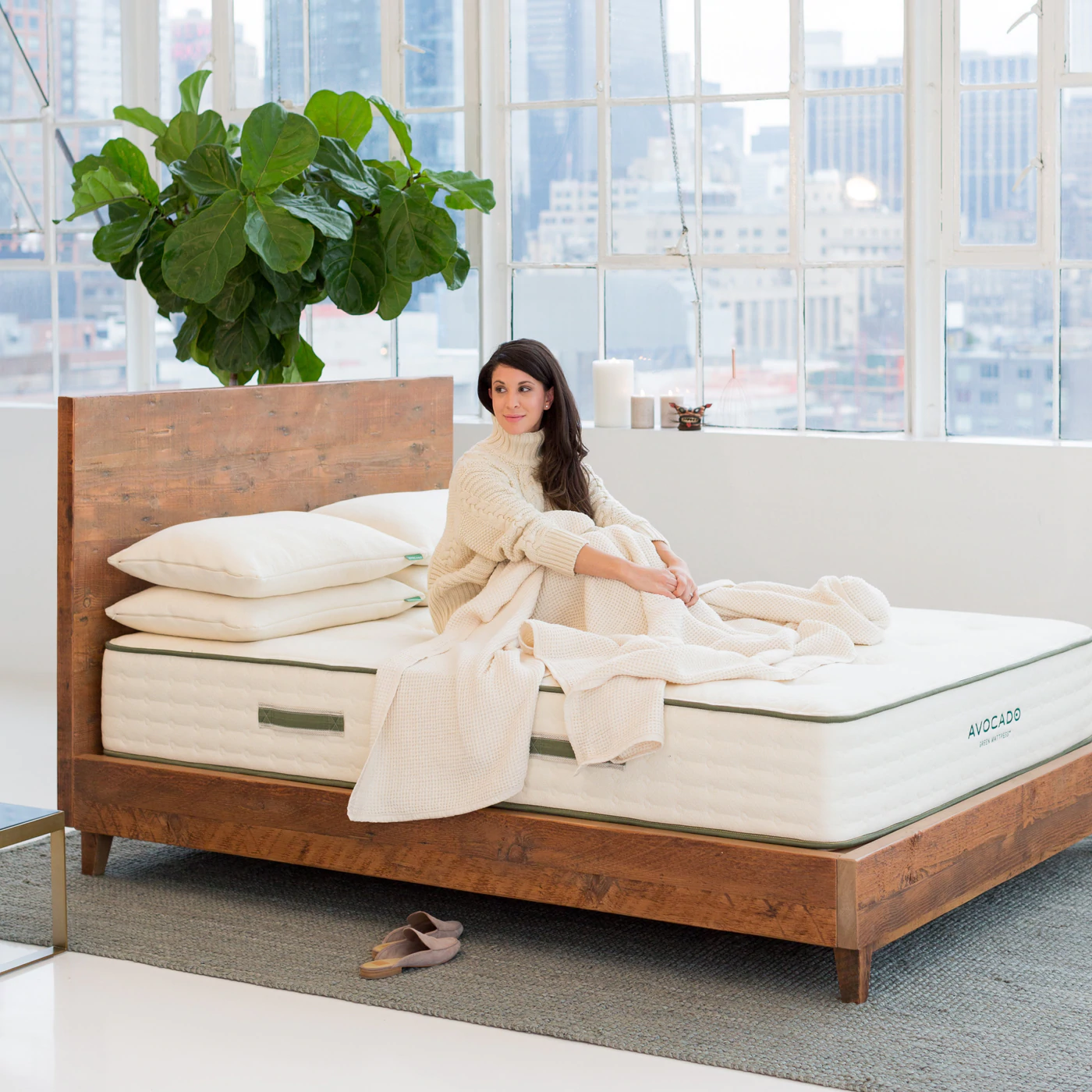
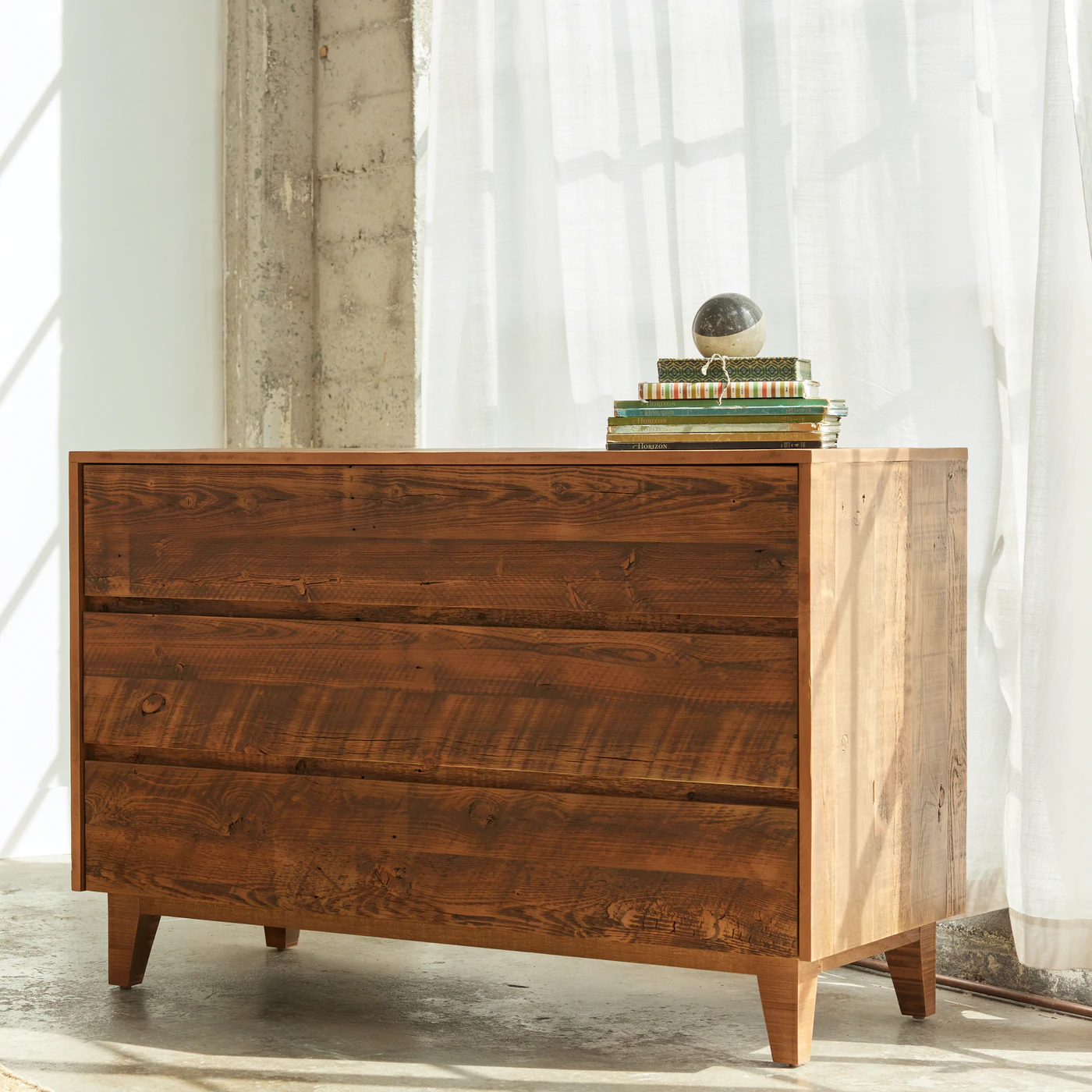
Carries: Mattresses, Bed Frames, Dressers, Nightstands, End Tables, Coffee Tables, Dog Beds (+ other home goods like bedding, pillows, skincare, and more)
Price Range: ~$199 – $4,599
Avocado carries mattresses, furniture, and lots of other home goods. (Here is our in-depth review of their Eco Organic Mattress.) First of all, they carry the most third-party certifications of any furniture brand, including MADE SAFE, Global Organic Textile Standard (GOTS), Global Organic Latex Standard (GOLS), Forest Stewardship Council (FSC), GREENGUARD, and more.
Their primary offering includes solid wood bedroom furniture which is made with water-based ECOS stains and Titebond® wood glues, which qualify as zero VOC.
Not only do they use reclaimed wood and other recycled materials for a lot of their wooden furniture, but their products are also carbon negative, their designs are zero waste and biodegradable, and they’re members of 1% For the Planet.
Plus, they’ve got a lot of low-risk consumer features like 1-year trials, 25-year warranties, and easy financing.
6. Burrow
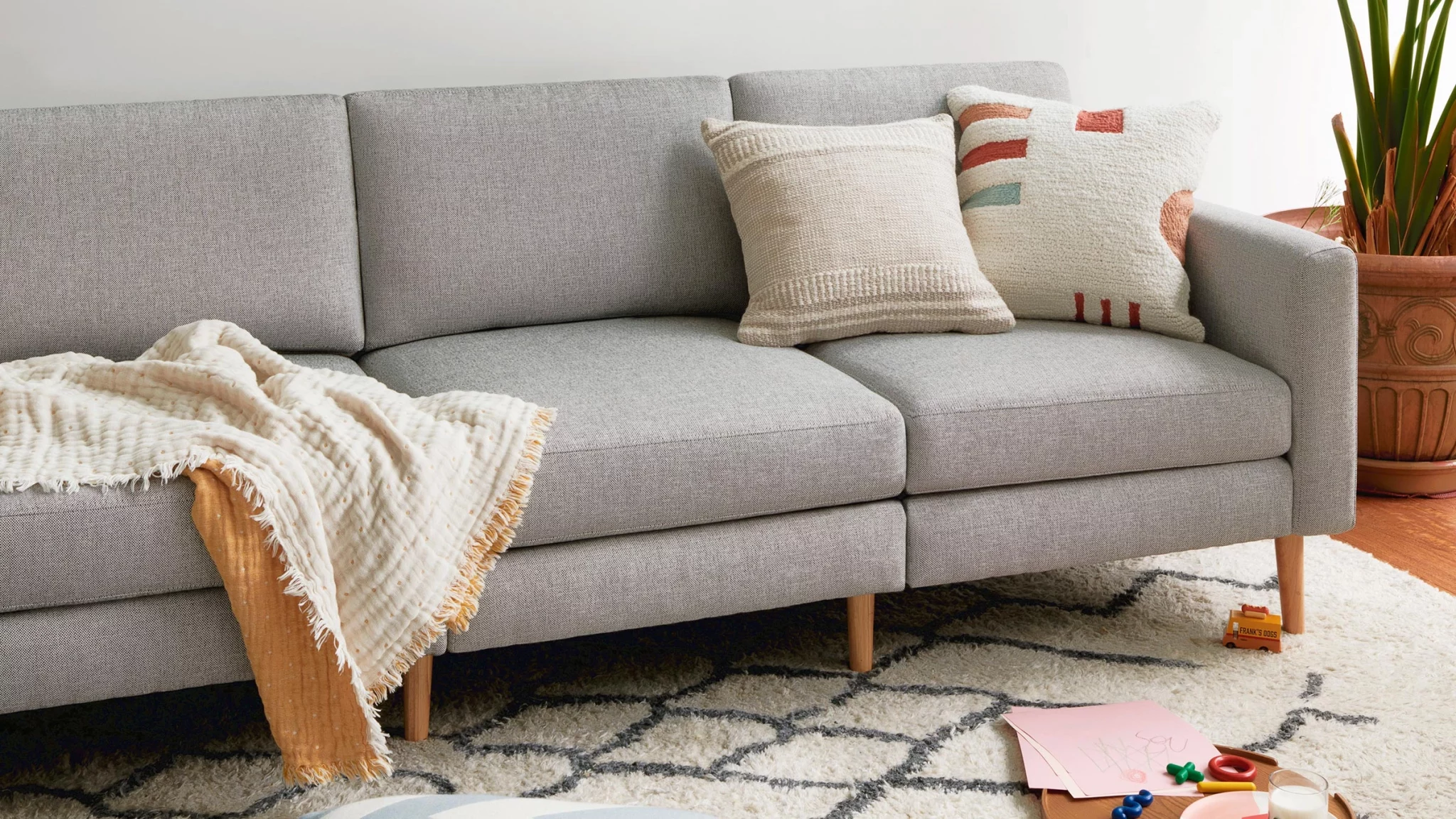
Carries: Sofas & Couches (including sectionals, sofa beds, and ottomans), Coffee Tables, End Tables, Bed Frames, Mattresses, Desks, Office Chairs, & More
Price Range: $245 – $6,795
It can be difficult to find affordable non-toxic furniture if you’re on a budget, but Burrow is worth looking into. They carry a non-toxic sofa that starts at $835 and their pricing is very comparable to what you’d find in the more conventional furniture industry. They also offer financing, which is not true of all non-toxic furniture brands.
Not only that, but Burrow’s furniture will hopefully last you a long time, even as you move from home to home. This is in part because of its modular design: it’s meant to be assembled, rearranged, and reconfigured for spaces (and families!) of different shapes and sizes.
Burrow uses Olefin for its upholstery fabric. Even though it’s synthetic, it’s made from polypropylene, which is one of the safer plastics. More importantly, it’s free from potentially dangerous chemicals like PFAS and flame retardants. They use a PFAS-free water-resistant alternative called C0 instead.
Their cushions are made with synthetic PU foam, but it is CertiPUR certified, which means it doesn’t include things like flame retardants or heavy metals.
Their coffee tables and other wooden furniture is made from sustainably-sourced hardwood and is free from toxic glues that contain high levels of formaldehyde and other VOCs.
Note that Burrow does use plywood in some of their pieces. For the most part, they use TSCA Title VI compliant MDF, which is made in Europe and contains absolutely no formaldehyde. The exception to this is the plywood used for their headboards, which is regular MDF. (We hope they change this soon!) Burrow has been very helpful and transparent in answering our questions, so don’t hesitate to reach out to them if you have any other questions!
To be sure: Burrow cannot be considered a “natural” or “organic” furniture brand. But we’re including them here because they are PFAS-free, “low-tox” in terms of other chemicals, have lots of options, and are available at an affordable price point.
7. Green Cradle
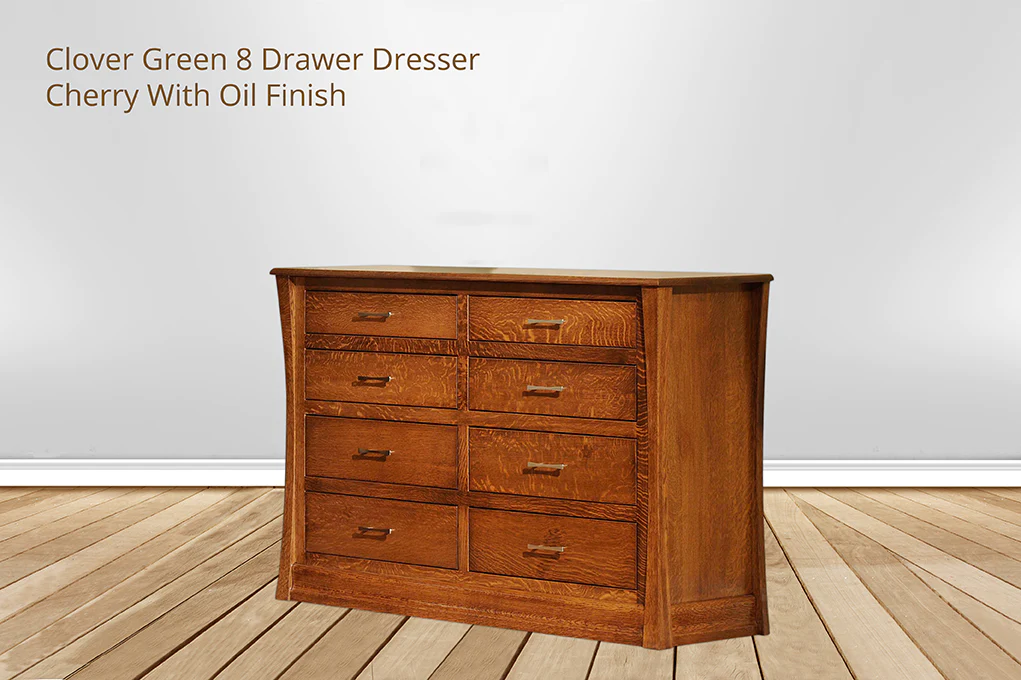
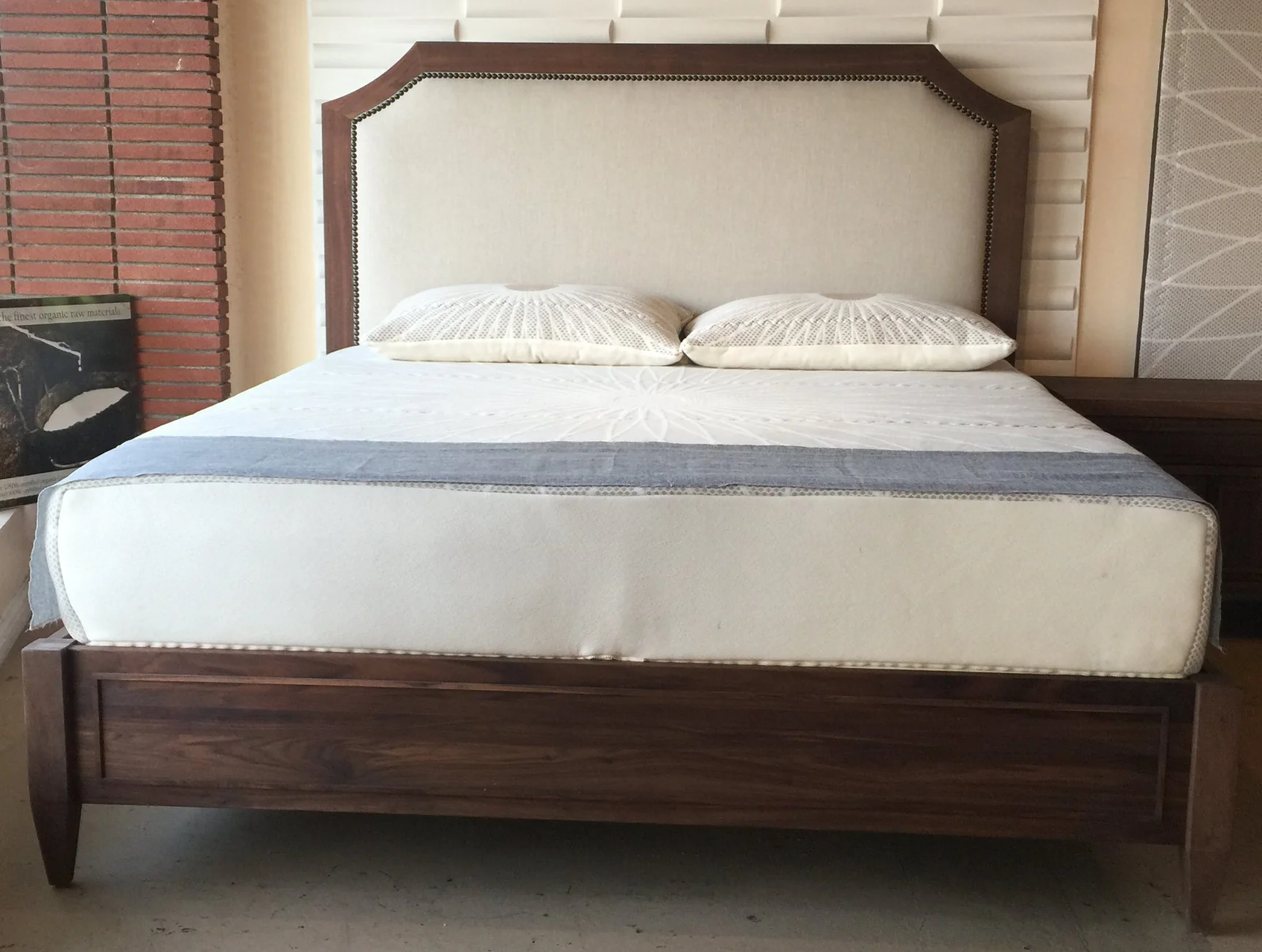
Carries: Dressers, Chests, Armoirs, Book Cases, Nightstands, Cribs, Beds, Cribs, Mattresses
Price Range: $1,195 – $8,200
Although Green Cradle offers options for nurseries and kids’ rooms (as the name indicates), they also offer furniture for adults as well.
They use materials like GOLS certified organic latex, GOTS certified organic wool, natural Belgian linen, slid wood, and formaldehyde-free finishes. (You can also get the furniture unfinished if you want.) They source their solid wood locally as much as possible, and they don’t use any engineered woods anywhere.
Their dressers, armoirs, bookshelves, and nightstands are pieces that you could pass down to your kids for generations. It’s all made by hand in the USA, too.
8. Sabai
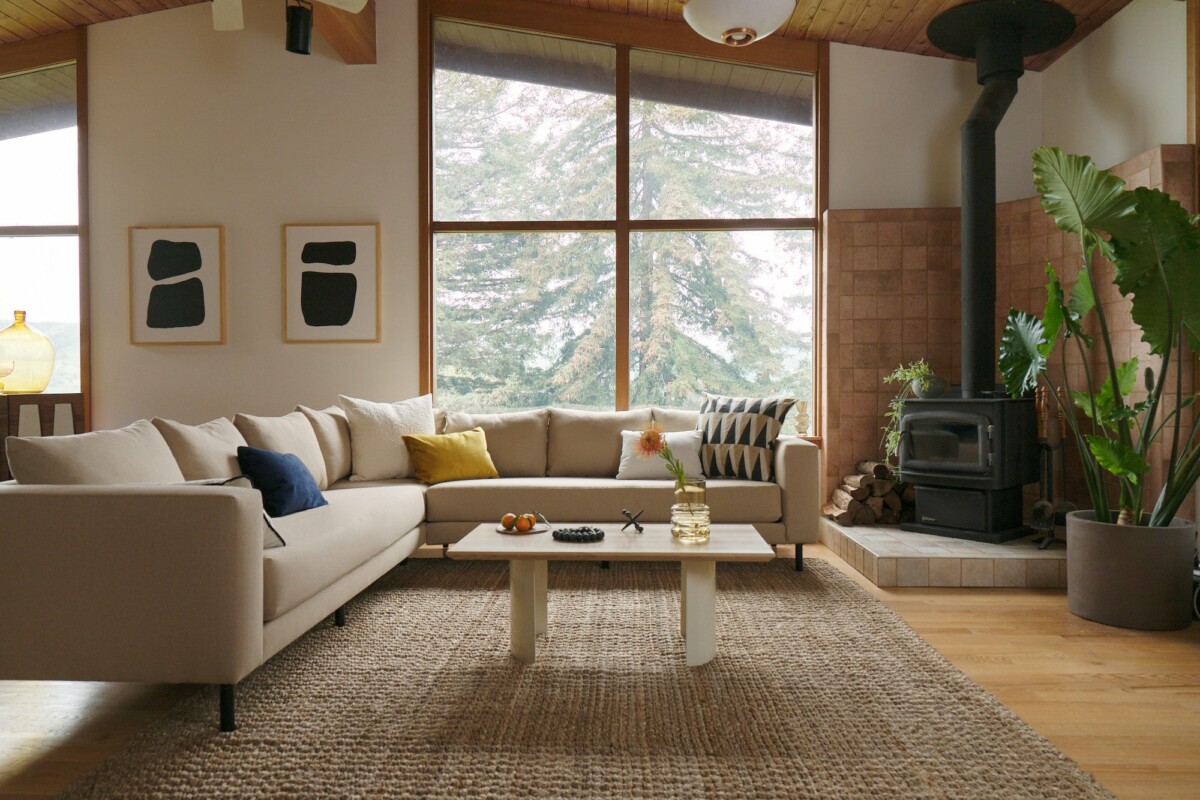
Carries: Sofas, Sectionals, Accent Chairs, & Ottomans
Price Range: $375 – $3,395
Sabai is another great option for affordable non-toxic couches.
None of their furniture contains any formaldehyde, flame retardants, or PFAS treatments. They use CertiPUR certified foams for their cushions along with FSC-certified solid wood finished with low-VOC stains. And they actually don’t use any glue at all!
Sabai is also a very sustainable company and is working to increase furniture circularity and decrease waste with their Repair and Replace program. This program allows you to repair your furniture as needed to get as many years as possible out of it. They also offer a Revive program, which allows you to re-sell your sofa or buy one secondhand at 30% off.
All of Sabai’s furniture is ethically made in a family-owned factory in High Point, North Carolina. In fact, 90% of their materials are sourced within 100 miles of their production facility!
Similar to Burrow, Sabai cannot be considered “natural” or “organic,” but they do have a lot of things going for them in terms of chemical reduction and overall sustainability efforts.
9. IKEA
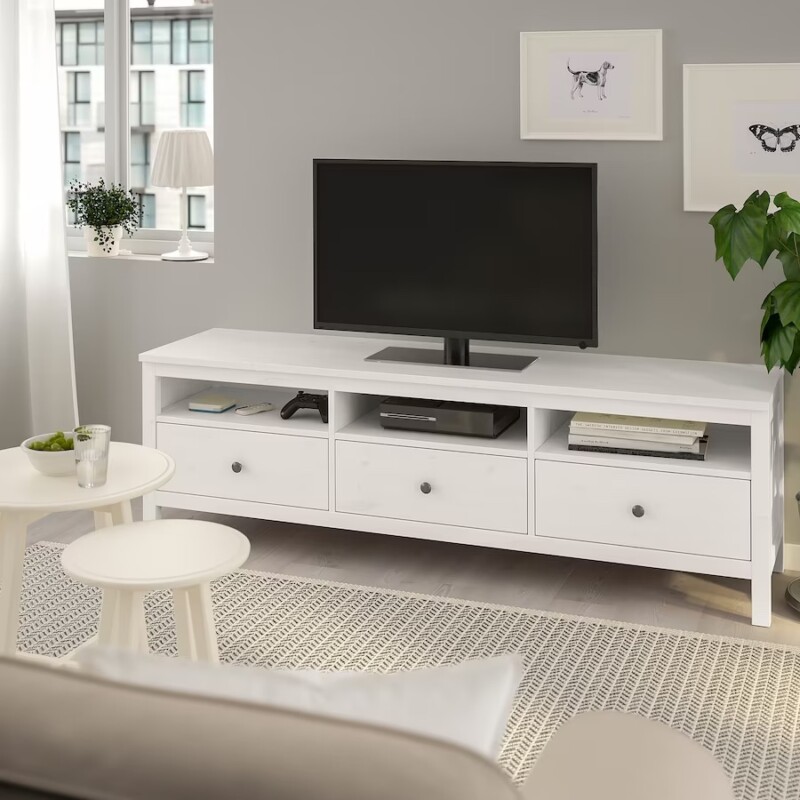
Carries: Pretty much all kinds of furniture
Price Range: ~$15 – $4,499
I’m sure you’re aware that IKEA’s furniture is not exaclty the highest quality. It’s known for being lightweigh, kinda flimsy, and lasting only a few years.
IKEA does use pengineered woods and pestroleum-based materials like PU foams throughout their collections, which is something to keep in mind as you make your decisions. However, their chemical policies aren’t really that bad, especially when you consider how affordable it is.
IKEA has been completely PFAS-free since 2016. They don’t use flame retardants except in the places where it’s still required by law (which is not the U.S. anymore). They have limits on a lot of other chemicals, including formaldehyde. Being based in Sweden, IKEA’s furniture has to meet the E.U.’s emissions standards, which are stricter than most other places.
You can learn more in our deep dive into IKEA furniture right here.
What About West Elm and Pottery Barn?
West Elm and Pottery Barn are also pretty good places to find affordable non-toxic furniture. They do have a lot of great initiatives when it comes to things like sustainability, fair trade, and the use of safe materials… But it often just comes down to which specific product you’re buying.
Much of their furniture is made under fair trade conditions using natural materials and is free from some of the worst offenders such as flame retardants. However, when it comes to other factors (like PFAS), it’s often really difficult to determine whether or not a specific piece of furniture is totally non-toxic. So after you pick out your favorite pieces, don’t be afraid to reach out and ask before you make your purchase!
What About Non-Toxic Outdoor Furniture?
Your options are very limited when it comes to outdoor furniture. This is because almost all outdoor furniture is treated with water- and stain-resistant chemicals that contain PFAS. But we do have a separate article breaking down your options for less-toxic outdoor furniture, which you can check out here.
Or as an alternative, you could go with a less conventional option like organic hammocks if it works with your outdoor space!
Home
PFAS-Free, Non-Toxic Outdoor Furniture Options That Are Durable & Eco-Friendly
Explore my top 5 picks for non-toxic and eco-friendly outdoor furniture. Ditch the PFAS and explore the safest options for you and your family.
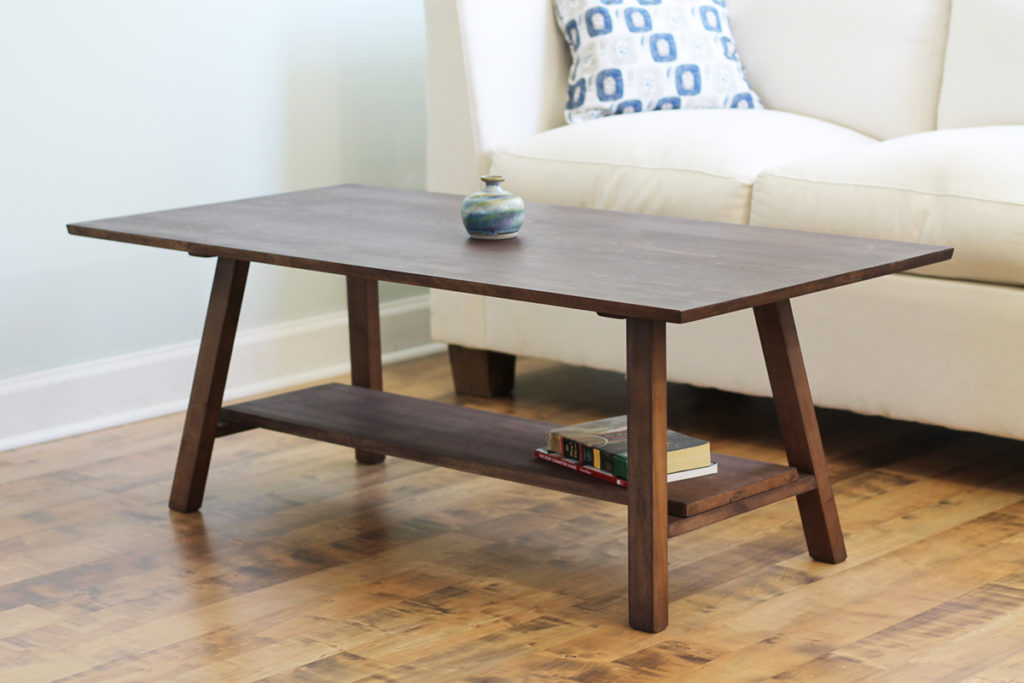
Related Guides:
If you’re looking for more specific furniture categories, check out our related non-toxic furniture guides:
- The Best Non-Toxic Sofas & Couches
- The Best Non-Toxic Bed Frames & Mattresses
- Our Picks for Non-Toxic Dressers
- The Complete Guide to Non-Toxic Bedroom Furniture
- Non-Toxic Office Furniture: Desks and Chairs
- These Are the Best Natural Wood Kitchen & Dining Room Tables
More FAQs About Non-Toxic Furniture
There are lots of questions about non-toxic furniture! If you’re looking for a specific answer, here are some of the most commonly asked questions:
Is the Smell From New Furniture Toxic?
Many people find that new furniture has a strong smell to it, and whether or not this smell is toxic just depends. In general, strong chemical smells can give you a sign that harsh (and potentially dangerous) chemicals are used, which can lead to reduced indoor air quality. This is why we recommend you avoid toxic chemicals by shopping from the eco-friendly furniture companies listed above.
However, just because new furniture has a strong smell doesn’t automatically mean it’s toxic. Even those who are chemically sensitive may even have a strong reaction to safe smells at high concentrations.
How Long Will Furniture Off Gas?
“Off-gassing” refers to the process of chemicals from furniture (or other products) evaporating from the product and into your air. (You can read more about that here). Many people are under the impression that if you let furniture off-gas for a certain amount of time, it will “complete” the process and stop emitting chemicals into your air.
But this is not always true. In fact, it depends on what kind of chemical we’re talking about. When it comes to certain materials like polyurethane foam, off-gassing actually gets worse as the product ages, since the material breaks down more and more. So depending on what it’s made out of, furniture may never actually stop off-gassing.
How Do You Get Formaldehyde Out of Furniture?
Although some formaldehyde will off-gas out of furniture (since it’s a VOC), you can’t really get formaldehyde completely out of furniture. Instead, you’ll want to try and purchase furniture that doesn’t come with a bunch of formaldehyde to begin with. You can do this by looking for furniture made with solid wood (instead of engineered wood) and minimal glues, adhesives, and lacquers.
Another solution is to use a product like AFM Safe Seal on the furniture that contains formaldehyde in order to “lock in” the formaldehyde and keep it from off-gassing.
Where Can You Buy Non-Toxic Furniture?
For the most part, the safest furniture companies are direct-to-consumer brands (like the ones listed above). However, you can also find non-toxic (or at least less toxic) furniture at some in-person stores like West Elm and/or Pottery Barn. (Although, not all of their furniture is non-toxic, so you’ll just have to do more research before buying.)
What is the Safest Furniture?
The safest furniture for children, those who are chemically sensitive or living with conditions like cancer or auto-immune disease, as well as people who are just trying to choose healthier furniture for preventative reasons is furniture that is made from solid wood and no- or low-VOC finishes and is free from toxic chemicals like flame retardants and PFAS-containing treatments.
What is Organic Furniture?
“Organic furniture” indicates that the materials used to manufacture the furniture are made without potentially toxic chemicals like pesticides. For example, the fabric used to upholster a couch may be made out of organic cotton. Or the latex inside of the cushions may be made from natural organic latex.
Usually, you’ll want to look for third-party certifications like GOTS or GOLS, which provide a level of accountability that the materials used are truly organic. However, certifications are not the end-all, be-all, and materials can still be technically organic even without a certification.
It’s very rare to find furniture that’s 100% organic since several kinds of materials (like wood) can’t really be certified organic. What’s more common is to find furniture made with some organic materials.
How Do You Know If You’re Buying Solid Wood Furniture?
Most furniture distributors will tell you in the product descriptions whether or not solid wood is used in their products. Try to avoid descriptors like MDF, plywood, engineered wood, and particleboard, as these are all indications that the furniture is NOT solid wood and likely contains high levels of formaldehyde.
Is Ashley Furniture Non-Toxic?
Ashley Furniture is not non-toxic. Although the large furniture brand did phase out toxic flame retardants (which is definitely a win!), it still uses other potentially harmful materials such as engineered wood, harsh glues and finishes, and PFAS-containing treatments.
Is Ethan Allen Furniture Toxic?
Similar to Ashley Furniture, Ethan Allen did ban flame retardants in their furniture, which is great news. They’ve also implemented several other safe and sustainable initiatives, including using low-VOC finishes and some solid wood. When it comes to Ethan Allen, some of their furniture is less toxic than others, so it’s ultimately up to you to do your research before buying.
Is Bamboo Furniture Toxic?
We’ve talked about the problems of bamboo before when it comes to fabric. (In summary, several of the chemicals commonly used to transform the bamboo plant into a soft and silky fabric are toxic.)
When it comes to furniture, however, there isn’t quite as much concern, since there aren’t as many chemicals needed to turn bamboo into wood. In general, bamboo furniture is considered non-toxic. However, just like with any other material, it ultimately comes down to how it’s processed and what is added afterward.
Is Metal Furniture Toxic?
For the most part, metal furniture is a safe bet since it doesn’t off-gas as much as other materials. If you choose to buy metal furniture, you may just want to wipe it down with an all-purpose non-toxic cleaner before using it in order to get rid of various oils and materials from the manufacturing process.
Additionally, it might be worth noting that some people are concerned that metal furniture could conduct EMFs more than other types of furniture, so that’s something to keep in mind.
Is Plastic Furniture Toxic?
Whether or not plastic furniture is considered toxic depends on the type of plastic used. You’ll want to avoid PVC as much as possible, opting instead for a safer synthetics like polypropylene.
Is Leather Furniture Toxic?
The leather furniture you’ll find on the market almost certainly contains toxic chemicals. This is mostly because almost all of it uses conventional leather (where heavy metals like chromium are used in the manufacturing process), as opposed to the safer and less toxic vegetable-tanned leather.
Although you’ll be able to find plenty of veggie-tanned bags, jackets, and other (smaller) leather products on the market, it’s nearly impossible to find a couch made out of vegetable-tanned leather. Ecobalanza (featured above) is one of the only brands that offers vegetable-tanned leather couches.
Do Leather Couches Have Flame Retardants?
It depends! Most of the time, flame retardants are added to polyurethane cushions, which most leather sofas do have. However, flame retardants have largely been phased out of many couches sold in the U.S. due to a California law that went into effect in 2020. So your chances of buying a leather couch that contains flame retardants have definitely gone down significantly. But you’ll still want to check with the furniture brand and/or reference the couch label before buying!
Is MDF Furniture Toxic?
MDF furniture is more likely to be toxic due to the fact that it uses a lot of formaldehyde to press it together. If you do buy furniture that uses MDF, look for CARB II and US TSCA Title VI compliance, which indicates low-formaldehyde emissions.
Is Pine Furniture Toxic?
Furniture made from natural pine wood is generally a good sustainable furniture option, but you want to make sure it’s made from solid pine wood, as opposed to manufactured wood (MDF). Also, don’t forget to check the finishes! You’ll want to buy solid wood furniture that uses water-based finishes and/or natural linseed oil. Even better: look for FSC-certified wood, which indicates that it’s been sourced from responsibly-managed forests.
Is Laminate Furniture Toxic?
Much like MDF, laminate furniture is often made using potentially toxic materials. Laminate essentially consists of synthetic materials that are made to look like wood. It can be quite difficult to find out exactly what is actually in laminate furniture, but it often contains things like formaldehyde (and other VOCs) as well as phthalates.
Does All Furniture Have Formaldehyde?
Technically, all furniture contains small amounts of formaldehyde since it’s a naturally occurring substance that is found in everything from trees to humans. However, the real problem with formaldehyde in furniture is due to the fact that there is SO much added formaldehyde from the glues, adhesives, and finishes. When formaldehyde exists in these high amounts is when it starts to become dangerous to human health.
To get more low-tox product picks, environmental toxin headlines, and other goodies delivered to your inbox once a week, sign up for Filtered Fridays.

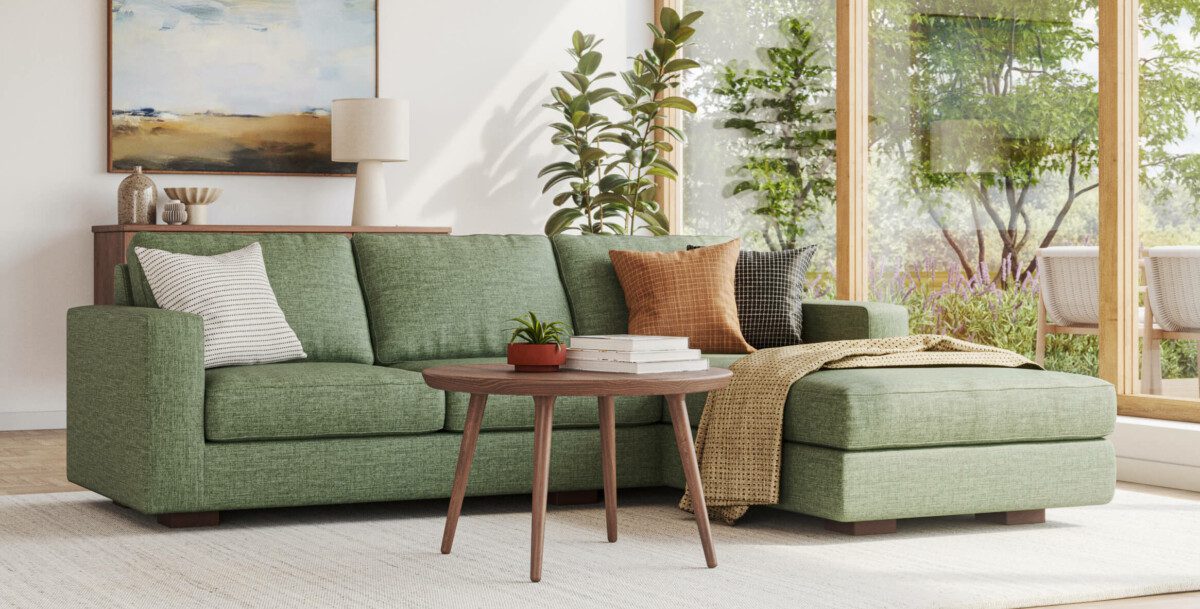
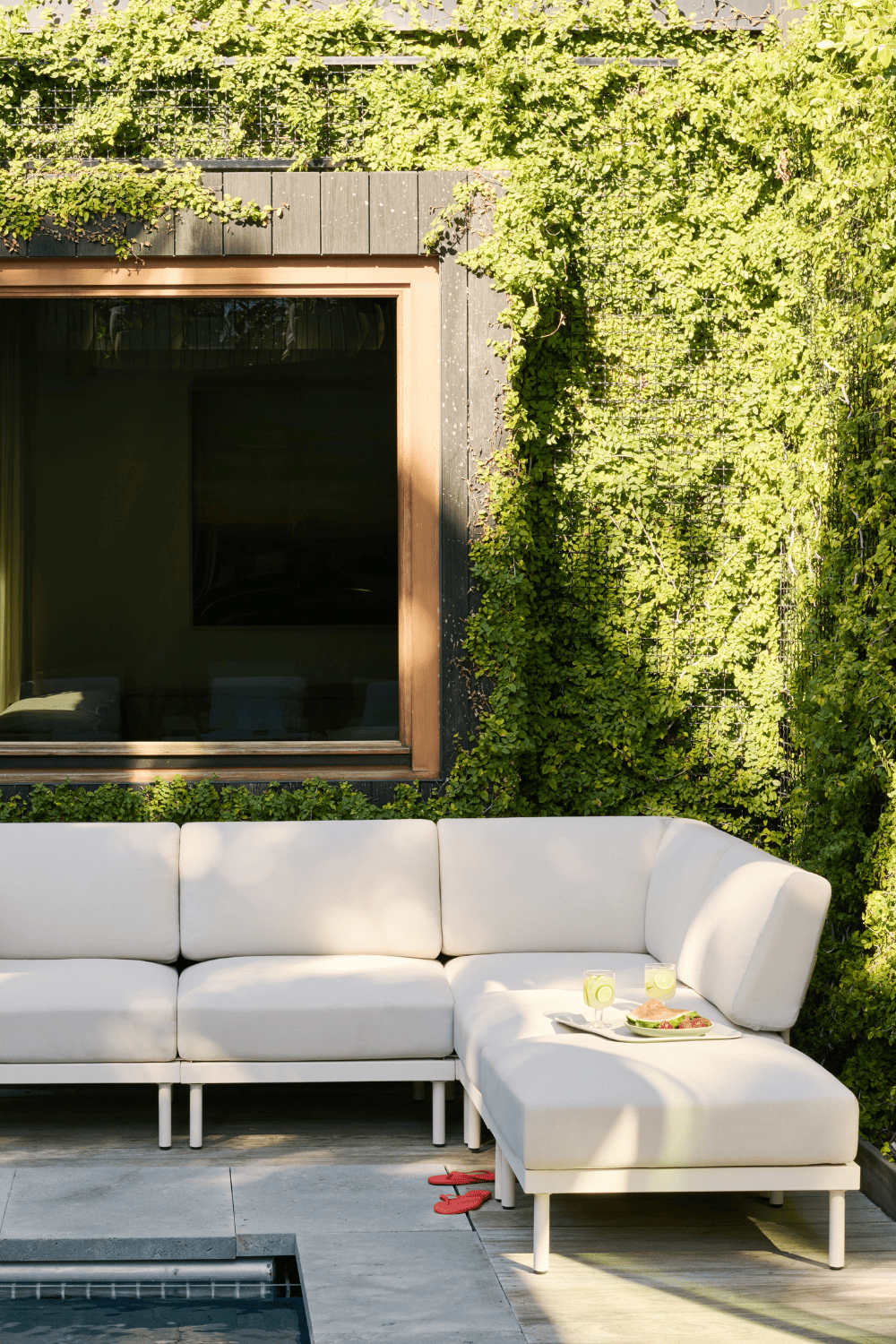




https://www.westelm.com/products/cp-bacall-2-piece-chaise-sectional-h10922/?pkey=csale-furniture
Thoughts on this couch? Or what couches from West Elm are best? I would love to order from Melody but we need a couch asap and they take forever to be delivered. Best nontoxic couches that are ready to ship? Thanks!
Hey Holly,
Yea, unfortunately, when it comes to West Elm’s upholstered furniture, it’s still really difficult to tell whether or not the fabric contains PFAS. I know Burrow has a Ready-to-Ship collection, so you could check that out to see if there’s anything you like…
When I clicked, I was expecting a brief listicle, not this incredibly informative and well-researched article. Thank you so much for sharing all of this information.
I’m currently sheltering in the bedroom of my 25th floor apartment with no openable windows to be as far away as possible from an Ashley sofa that I had delivered last week. From the moment I received it the chemical smell was pungent. I was confused because the website boasts about flame retardant-free and formaldehyde-free furniture. The couch even has a required-by-law sticker on it to the same effect. I’ve been suffering from headaches and dizziness for the last week, and I can feel my eyes water and throat constrict when I walk into the living room.
The first day, I purchased several large boxes of baking soda and covered the couch and cushions for 24 hours before vacuuming it up. The second day, I started running two large air purifiers at either end of the couch, which seemed to at least make a small dent in the chemical smell. The third day I repeated the baking soda exercise and started running the central AC fan 24/7 along with the air purifiers to encourage circulation. 7 days in, I now have 4 air purifiers running around my apartment (all with large carbon filters) and have seen no relief from these symptoms.
My plan is to try and return the sofa or, failing that, to dispose of it. I’ve almost spent as much on air purifiers now as the sofa itself. It was an expensive lesson, but I feel better equipped to purchase something else with the info you provided here.
Oh wow… I’m so sorry you’re having this experience! I hope you’re able to return it or get rid of it somehow and get some of that money back. It’s hard to say what exactly could be causing that reaction… It be a combination of chemicals used for what I’m assuming is PU foam cushions and/or fabric finishes, but it could also potentially be something that was sprayed onto the finished sofa as a pesticide/fungicide right before shipping.
Thanks for the good info. Do you know of any furniture companies that do not use Dimethyl fumarate (DMF) in their furniture — in the leather or in the desiccant packets?
Hi Jack,
Great question! We will have to reach out to these companies to ask them specifically about this one.